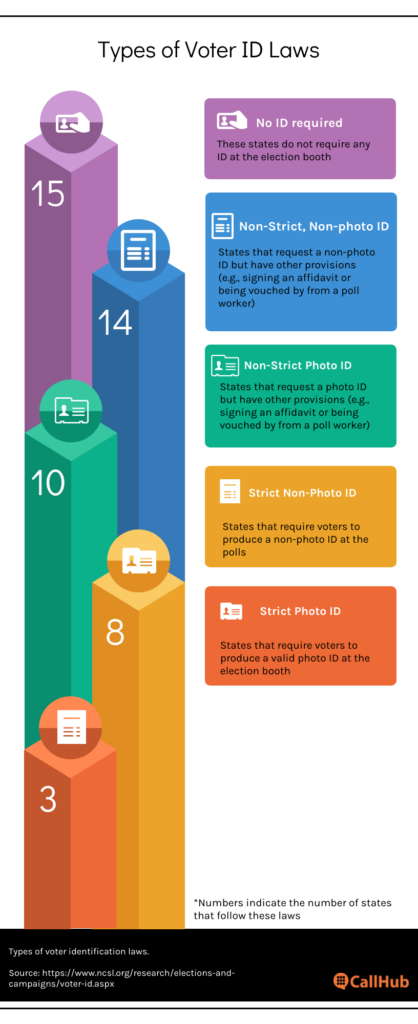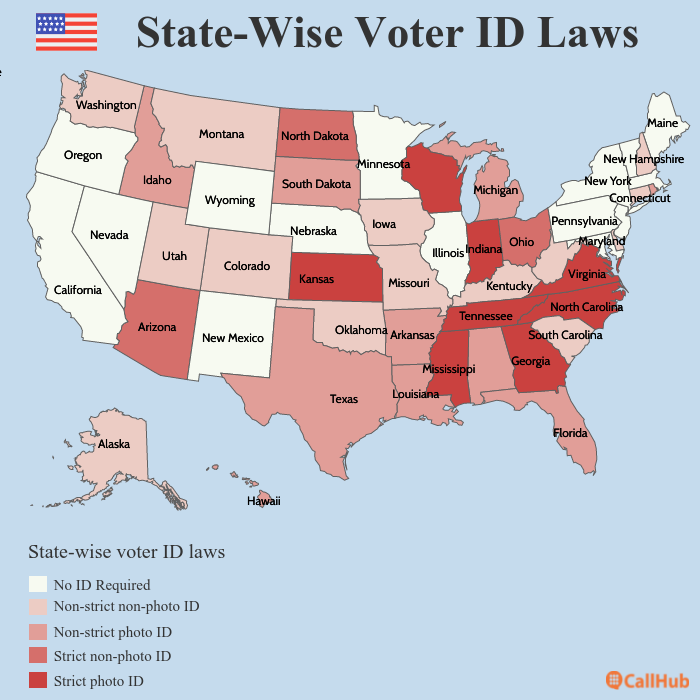The federal voter identification laws mandate official and valid identification papers
- When registering to vote OR
- When receiving a ballot OR
- At the election booth.
Additionally, as of May 2022, 36 states in the USA have voter identification laws requiring electorates to produce a valid ID at the election booth, regardless of whether they submitted the documents earlier.
While the form of voter ID and strictness varies by state, the laws have created quite a stir with advocacy groups, voters, and others. Supporters of the voter identification laws say that these rules prevent voter fraud.
Critics argue that these laws lead to voter suppression, given that 11% of eligible voters don’t have the required ID, and getting a new one can be expensive or inaccessible.
Irrespective of where you stand (we are non-partisan) on the debate, you must know the state-wise laws before elections for smooth voter registration and voting process. So, here we list the types of and state-wise voter identification laws true of May 2022.
Types of voter identification laws
In 1950, South Carolina became the first state to mandate a non-photo ID at the booth, and over the years, several states followed this precedent. Until 2004, these laws were mostly uncontroversial, with a more rigid rule (in Virginia) getting struck down by the opposition.
However, the tables turned in 2004 when Arizona mandated a photo ID at the booth. Next year Indiana followed suit, and although there was staunch opposition (citing discrimination against minority groups), the law was withheld by the Supreme Court—paving the way for 30+ other states to have similar voter identification laws.
It’s important to note that there are variations in the kind of identification, and while some states have “strict” voter identification laws, others have “non-strict” laws. Let’s look at what that means.
1. Photo ID Vs. non-photo ID laws

A photo identification, as the name suggests, is an official identification document with the holder’s photo on it. Acceptable photo identification documents include:
- A valid driver’s license (some states require it to be issued in that state itself. Some states accept a license that expired not more than 60 days before. Please check your state laws before election day).
- State Election Identification Certificate
- Personal Identification Card issued by the state Department of Public Safety (DPS)
- United States Military Identification Card
- United States Citizenship Certificate
- A US passport
Some states also accept a Handgun License as a photo ID.
Acceptable non-photo IDs include:
- Utility bills
- Bank statements or credit union bills (dated within 90 days of the election date)
- State vehicle registration or insurance
- Property tax statements
- Voter registration card
- Recorder’s certificate
- Census card
- Tribal identification (e.g., Tribal enrollment card)
- Any mailing or identification labeled as “official election material”.
With that, we move on to the strictness of voter ID laws.
You May Also Like: How Democrats Abroad Drove 300% Increase in Overseas Voter Turnout with Phone Calls.
2. Strict Vs. Non-strict state voter identification laws
States with strict voter identification mandates do not make exceptions and need the voter to produce any one of the acceptable documents at the election booth. The required ID can be a photo ID or a non-photo ID depending on the state.
Non-strict states are more lenient, and if a voter doesn’t possess any required ID, they may:
- Sign a sworn affidavit attesting to their identity.
- Sign a reasonable impediment declaration.
- Have one of the poll workers vouch for them.
First-time voters may have more requirements on top of the above voter identification laws. Let’s look at them before going into the state-wise voter identification laws.
Voter identification laws for first-time voters
The Help America Vote Act (HAVA, 2022) is a federal law that dictates minimum voter identification requirements and standards for states. Under the HAVA act, states require first-time voters who registered to vote by mail but have not provided identification or verification documents at the time of registration to produce such documents at the voting booth. The document could be any of the following:
- A current and valid photo identification document,
- A copy of a recent utility bill,
- Paycheck,
- Bank statement,
- Government check or other government-issued documents.
The HAVA has issued these voter identification laws on top of the state laws. For instance, states with non-photo ID or non-strict or no requirements must still ask for such documents from first-time voters under said conditions.
Read Next: Political Canvassing Laws Every Campaigner Must Be Aware Of
State-wise voter identification laws

Photo-id laws have always invited controversy from the Democrats. When Indiana passed the first strict photo ID law in 2005, the Marion County (Indianapolis) Democratic Central Committee challenged it, citing obstacles against the 14th amendment. However, the courts struck down that challenge, saying that the state had a reasonable interest in introducing such election laws.
It’s 17 years later, and more and more states have adopted some variation of the photo ID law. Missouri is the latest in line, but that law is still in progress and hasn’t yet passed while I write this article.
Here is a breakdown of how many and which state follows which of the voter identification laws:
- 18 states require/request a photo ID
- 17 require/request a non-photo ID
- 11 states have strict voter identification laws
- 24 states have non-strict voter identification laws
- 15 states do not require or request an ID at the election booth.
| Photo ID | Non-photo ID | |
| Strict | Georgia Indiana Kansas Mississippi North Carolina Tennessee Virginia Wisconsin | Arizona North Dakota Ohio |
| Alabama Arkansas Florida Hawaii Idaho Louisiana Michigan Rhode Island South Dakota Texas | Alaska Colorado Connecticut Delaware Iowa Kentucky Missouri Montana New Hampshire Oklahoma South Carolina Utah Washington West Virginia |
| No ID required | California Illinois Maine Maryland Massachusetts Minnesota Nebraska Nevada New Jersey New Mexico New York Oregon Pennsylvania Vermont Wyoming |
Exceptions to voter ID law
States with strict voter identification laws (photo or non-photo) also sometimes make exceptions to accommodate beliefs or circumstances. Currently, 7 states make such exceptions. Let’s look at them in this table.
| State | Existing voter ID law | Exceptions |
| Indiana | Strict photo ID law | ◉ Religious objections to getting photographed ◉ Are needy/poor |
| Kansas | Strict photo ID law | ◉ Religious objections to getting photographed |
| Mississippi | Strict photo ID law | ◉ Religious objections to getting photographed |
| South Carolina | Non-strict non-photo ID law | ◉Religious objections to getting photographed ◉ Voter has a “reasonable” impediment to getting a voter ID. |
| Tennessee | Strict photo ID law | ◉ Religious objections to getting photographed ◉ Are needy/poor |
| Texas | Non-strict photo ID | ◉ Religious objections to getting photographed ◉ Voter does not possess a voter ID as a result of a natural disaster |
| Wisconsin | Strict photo ID law | ◉ Religious objections to getting photographed ◉ Victims of domestic abuse, sexual abuse, or stalking who have a “confidential listing.” |
Data Source: NCSL.
The way forward
Strict voter ID laws have faced criticism for being discriminatory against minorities and people with disabilities. States have also faced ire for issuing vague laws for acceptable IDs. However, there are government resources that can help you with the required information and guidance on how to get a valid voter ID in your state.
Here’s a helpful resource if you need verified and reliable information on
- State and federal election date
- Voter identification requirements
- Eligibility criteria in your state
- Registration status and ballot tracking
- Contact information for the local election office.
Feature image source: mansour ehsani/Unsplash.


